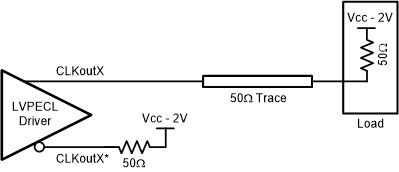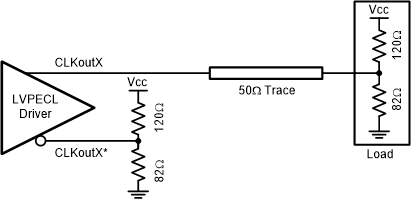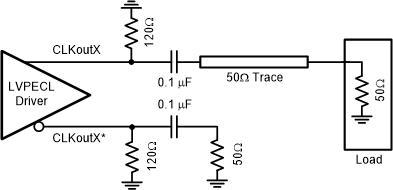JAJSGV2D January 2012 – September 2021 LMK01801
PRODUCTION DATA
- 1 特長
- 2 アプリケーション
- 3 概要
- 4 Revision History
- 5 Device Comparison
- 6 Pin Configuration and Functions
- 7 Specifications
- 8 Parameter Measurement Information
-
9 Detailed Description
- 9.1 Overview
- 9.2 Functional Block Diagram
- 9.3
Feature Description
- 9.3.1 High-Speed Clock Inputs (CLKin0/CLKin0* and CLKin1/CLKin1*)
- 9.3.2 Clock Distribution
- 9.3.3 Small Divider (1 to 8)
- 9.3.4 Large Divider (1 to 1045)
- 9.3.5 CLKout Analog Delay
- 9.3.6 CLKout0 to CLKout11 Digital Delay
- 9.3.7 CLKout12 and CLKout13 Digital Delay
- 9.3.8 Programmable Outputs
- 9.3.9 Clock Output Synchronization
- 9.3.10 Default Clock Outputs
- 9.4 Device Functional Modes
- 9.5 Programming
- 9.6 Register Map
- 10Application and Implementation
- 11Power Supply Recommendations
- 12Layout
- 13Device and Documentation Support
- 14Mechanical, Packaging, and Orderable Information
パッケージ・オプション
メカニカル・データ(パッケージ|ピン)
- RHS|48
サーマルパッド・メカニカル・データ
- RHS|48
発注情報
10.1.1.2.3 Termination for Single-Ended Operation
A balun can be used with either LVDS or LVPECL drivers to convert the balanced, differential signal into an unbalanced, single-ended signal.
It is possible to use an LVPECL driver as one or two separate 800 mVpp signals. When using only one LVPECL driver of a CLKoutX/CLKoutX* pair, be sure to properly terminated the unused driver. When DC coupling one of the LMK04800 family clock LVPECL drivers, the termination should be 50 Ω to VCC - 2 V as shown in Figure 10-12. The Thevenin equivalent circuit is also a valid termination as shown in Figure 10-13 for Vcc = 3.3 V.
 Figure 10-12 Single-Ended LVPECL Operation, DC Coupling
Figure 10-12 Single-Ended LVPECL Operation, DC Coupling Figure 10-13 Single-Ended LVPECL Operation, DC Coupling, Thevenin Equivalent
Figure 10-13 Single-Ended LVPECL Operation, DC Coupling, Thevenin EquivalentWhen AC coupling an LVPECL driver use a 120 Ω to 240 Ω emitter resistor to provide a DC path to ground and ensure a 50 Ω termination with the proper DC bias level for the receiver. The typical DC bias voltage for LVPECL receivers is 2 V (See Section 10.1.1.2.2). If the companion driver is not used it should be terminated with either a proper AC or DC termination. This latter example of AC coupling a single-ended LVPECL signal can be used to measure single-ended LVPECL performance using a spectrum analyzer or phase noise analyzer. When using most RF test equipment no DC bias point (0 VDC) is required for safe and proper operation. The internal 50 Ω termination of the test equipment correctly terminates the LVPECL driver being measured as shown in Figure 10-14.
 Figure 10-14 Single-Ended LVPECL Operation, AC Coupling Rem=120 Ω to 240 Ω
Figure 10-14 Single-Ended LVPECL Operation, AC Coupling Rem=120 Ω to 240 Ω